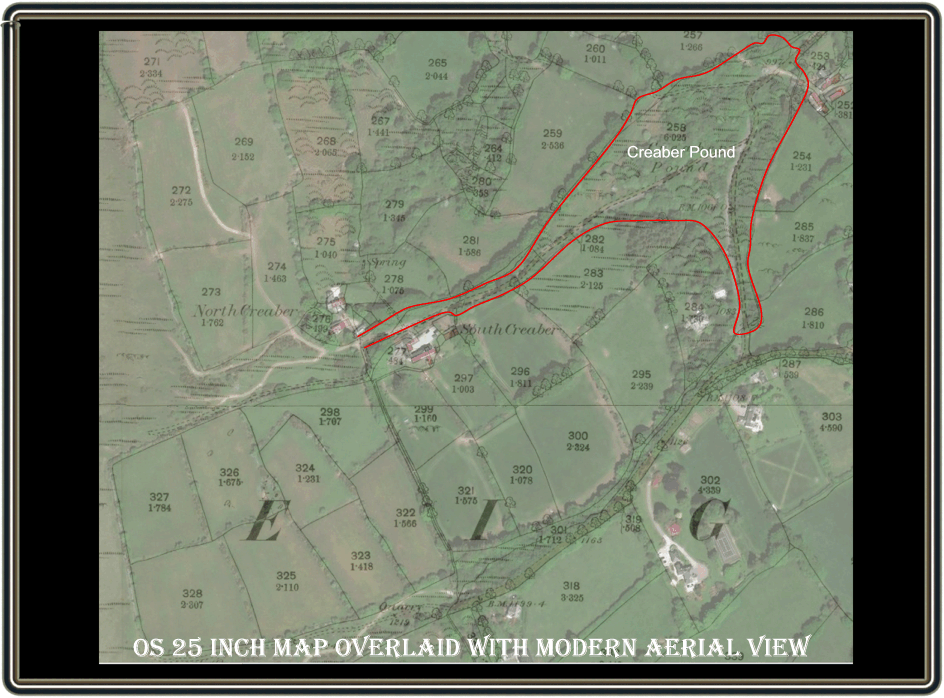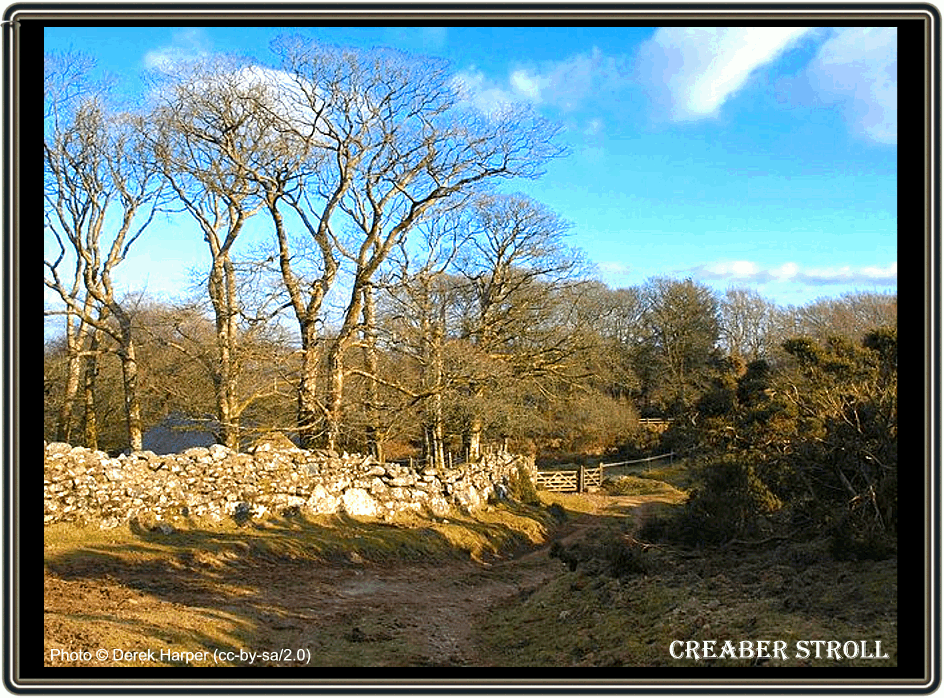
“As we are again on the Moor we may as well descend upon Gidleigh by way of Creaber Pound; not the old structure, which has long since disappeared in newtake walls, but a piece of enclosed common at the foot of the Moor, through which strangely enough, the road passes. At ‘drift’ time this road, or rather track,is closed at each end, making the pound complete. It must be confessed, however, that an enclosure less like a pound does not exist, and a stranger might pass between the irregular line of its walls times without number ere discovering he was within one of the drift pounds of Dartmoor.” J. Ll. W. Page, p.93.
Livestock Pounds have been a feature of the Dartmoor landscape since prehistoric times, normally recognisable by a granite walled enclosure that can be found on the open moor or in the surrounding towns and villages. However, there is always one exception and in this case that is – Creaber Pound. Why might that be you may well ask? well its because it has no defined enclosure and simply consists of an open space of common land. Why bother with writing a page on Creaber Pound? simply because it is such an exception to the rule and deserves some recognition of its uniqueness in the realms of Dartmoor’s landscape history. There is no field evidence of a livestock pound whatsoever, no walled enclosure or pound keepers shelter etc. The only suggestion of a pound can be found in the tithe apportionment of 1843 where two field numbered 272 and 273 belonging to North Creaber farm are listed as Higher and Lower Pound Close.
As can be read above – Creaber Pound belonged to the Parishioners of Gidleigh and was where stray animals would be brought from the drifts held in the East Quarter of the moor. Arrangements for these drifts differed slightly from those conducted by the owners of the Ancient Tenements. The onus on carrying out the drifts here was the responsibility of the local ‘Moormen’ or the venville farmers and Duchy officials. It has been suggested by documentary evidence that Creaber Pound dates to around the 17th century and possibly even earlier. A Duchy record of 1737 notes how one “W Bennett was struck several times by John Mallard whilst in Creaber Pound taking Account of the cattle.” A clear indicator that at times the owners of impounded livestock took exception to the loss of their animals and the ensuing redeeming fine.
Anyone who is familiar with this website will know that I have a ‘thing’ about place-names and their origins. In the case of Creaber Pound there are two possibilities; firstly that the name comes from the old Anglo Saxon word – ‘crib‘ which meant a stall, alluding to somewhere to contain animals. The second suggestion is that it derives from the old Anglo Saxon words – crãwan meaning ‘crow’ and beara meaning ‘wood’ thus arriving at ‘wood of the crows’
Today Creaber Pound is little more than a diamond shaped area of common land which lies between North and South Creaber farms. The sides are enclosed and at each end would have stood a gateway, only the one post of the lower gateway remains and this gateway was/is called Tipson Gate. Water was supplied to the pound via the Gidleigh Leat which flows along the northern verge of the enclosure. It is also very noticeable how high the old granite walls are in comparison with other parts of Dartmoor and according to Hemery this was because they were specifically designed to keep out the wolves which once roamed the Moor, p.803.
As can be seen above Creaber Pound is clearly marked on both the early OS six inch map and on the 1843 tithe map. In this year the Apportionment documented the pound as being – The Tithe Apportionment for Gidleigh, 1843. Landowners: parishioners – Plot Number: 262 – Plot Name: Creaber Pound – Cultivation: coarse pasture – Size: 6 acres, 1 rood, 21 perches. As Mr. Page described the mechanisms of the stroll were that a gate would be placed at the top end of the pound and the animals driven off the moor and into Creaber Stroll. This was the narrow track running between the enclosure walls which eventually led into the open space of the pound where they would collect. Once the last beast had entered the stroll Tipson Gate would be closed thus ensuring no animals could escape back onto the moor. Incidentally, on Dartmoor a ‘stroll’ comprises of a space between enclosure walls which was designed to allow the herding of livestock on to or off of the Moor. They normally led from a farm with a gate at the top end which then allowed free access to the open Moor or a newtake at its lower end. When open the strolls also afforded a place where livestock could shelter in bad weather. Occasionally these features were also known as ‘Tongues’ as in Moor Tongue at Hexworthy.
I suppose in a way the modern equivalent of livestock pounds is the dog pound? If a dog strays the council must seize such dogs and if they cannot be returned immediately to their owner they must be taken to the council stray pounds where they are held for a mandatory period of 7 days. After the 7-day period, the dog legally becomes the property of the kennels and the kennels can either rehome the dog to a new owner, keep the dog at the kennels or, following veterinary advice, put the dog to sleep. So in a similar light William Crossing informed us that “According to a statement made by Sir Thomas Reynell, to whom the Forest was let in the time of Charles I, respecting an estray (in law any domestic animal roaming at large or lost, especially if the owner is unknown) driven to this pound (Creaber), it was then the custom to make four drifts for cattle on Dartmoor, one in each of the four quarters… Those found in the north quarter to Creaber. Any not claimed within three days were driven to Lydford, where there was also a pound, adjoining the castle, where they remained as estrays, and were forfeited if not claimed by the 24th of August. This statement was in the form of a bill filed in the Exchequer against Oliver Warren, the owner of the estray in question, a black ox, which not having been claimed was driven to Lydford. Still remaining unclaimed, it was forfeited to Sir Thomas, its value being appraised at 56s 8d.” Dartmoor’s Early Historic and Medieval Remains, p.33.

Crossing, W. 1987. Dartmoor’s Early Historic & Medieval Remains. Brixham: Quay Publication.
Hemery, E. 1983. High Dartmoor. London: Robert Hale.
Page, J. Ll. W. 1895. An Exploration of Dartmoor. London: Seeley & Co. Ltd.
 Legendary Dartmoor The many aspects past and present of Dartmoor
Legendary Dartmoor The many aspects past and present of Dartmoor




